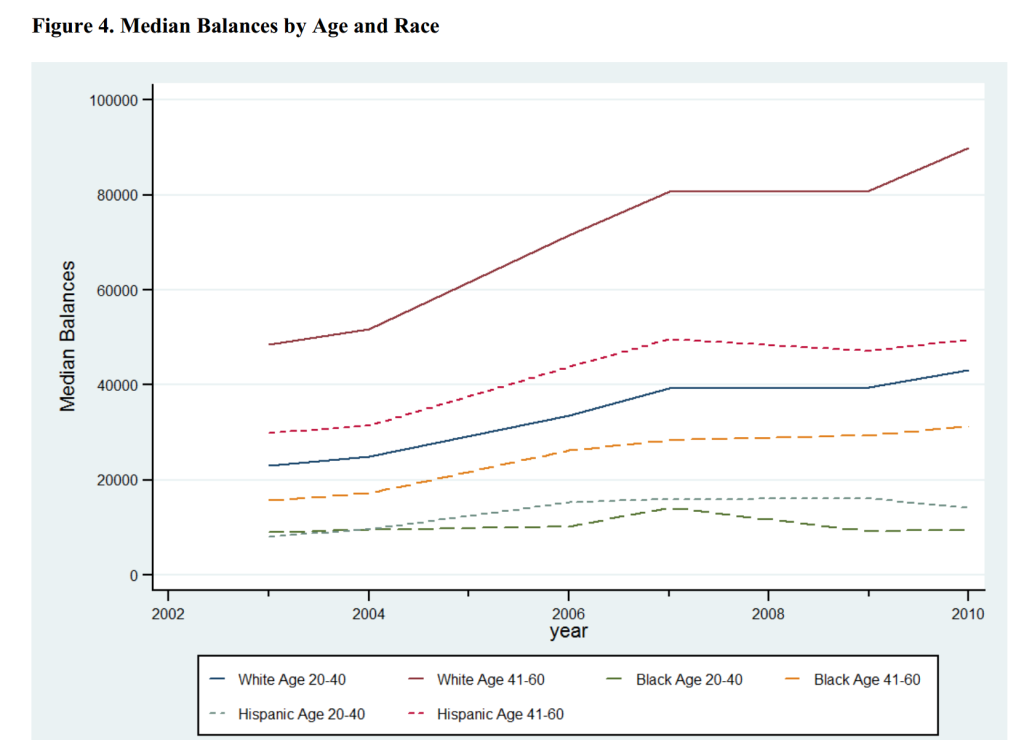
Tag: Economics
How 401(k) accounts widen race/ethnic wealth disparities
My latest Wonkblog column is based on a recent NBER working paper that examined 401(k) contributions and withdrawals among continuously-employed workers at a single firm between 2003 and 2010.
Few workers at this firm set any land speed records for saving and investing. But the race/ethnic disparities in saving remained really striking. Ironically, minority workers contributed surprisingly similar amounts to their non-Hispanic white counterparts. Yet they were vastly more likely than their white counterparts to make withdrawals or to borrow against their 401(k) funds. Minority workers were also much more likely to invest their money in money market funds and other safe assets that bring really low rates of return.
Continue reading “How 401(k) accounts widen race/ethnic wealth disparities”
Wherein the Nonprofiteer Does a Literature Review and Endorses an Increased Minimum Wage
Over on The Nonprofiteer, I demonstrate my recovery from the Chicago School of economics by reviewing arguments for (and even one against) an increase in the minimum wage. Not sophisticated but (I hope) clear.
From Phlebas to IKEA
The millennial survival and dominance of patrimonial firms.
 The photo (source) shows a painted inscription on the neck of an olive oil amphora found at Vindolanda, a small Roman garrison town on Hadrian’s Wall. The most visible part reads Aemiliorum et / Cassiorum, referring to the shippers of the olive oil, the firm or firms of the Aemilii and Cassii.
The photo (source) shows a painted inscription on the neck of an olive oil amphora found at Vindolanda, a small Roman garrison town on Hadrian’s Wall. The most visible part reads Aemiliorum et / Cassiorum, referring to the shippers of the olive oil, the firm or firms of the Aemilii and Cassii.
The only business firms at the time were family ones. Shipping posh olive oil from Provence (1600 km by cart and barge) or Andalusia (ca 2500 km by ship) to an officers’ mess at the cold northern edge of the Roman Empire was a risky business, absent banks, insurance, or bills of exchange. [Update 4/12: I badly underestimated Roman trade finance; see comments.] To spread the risk, it made sense for the Aemilii and Cassii to join forces.
Family firms are popular with the writers of soap operas, in Brazil as much as the USA. (The best British example, the mordant Steptoe and Son about anachronistic rag-and-bone men with a horse-drawn cart, was satire with no pretence at economic realism.) The familiar emotional conflicts within a family are heightened and given wider repercussions by the less familiar but comprehensible context of lots of money. It’s only recently that soaps have ventured into the technically much more difficult environment of the modern bureaucratic corporation (Mad Men, The Office).
Art draws loosely on life, but doesn’t reflect it statistically. It’s said that Victorian novels frequently used both adultery and quicksands as exciting plot devices. From independent evidence, we know that adultery is very common and quicksands are very rare; but you would not learn this from the novels.
In this case the soaps get it more right than the economics textbooks. The vast majority of the world’s capitalist firms are family ones, even leaving out family farms. In the US, 80% of all firms are family-controlled; and “in about 65% of firms with 1993 revenues of over $5 million, at least 50% of the ownership was concentrated in a single family”. And not just small ones: “about 35% of the Fortune 500 firms are largely controlled by family interests”. (Gomez-Meija et al, pdf page 3, paywall; h/t Nadia Tronchoni in El Pais; thanks to Mike O’Hare for forwarding me the paper.)
My daughter Sarah works in one of the many family businesses in the Lille area. The grandest of these are the Mulliez dynasty: the 550 descendants and inlaws of a fertile 1920s patriarch between them control a retail empire guesstimated to be worth €30 bn. It includes 3,051 Auchan supermarkets and hypermarkets (now in Russia and China), hundreds of Leroy-Merlin DIY superstores, and half of the Decathlon sportsgear shops.
You would suppose that family control makes a difference. You would be right. The CW is that family controlled businesses are risk-averse. The paper by Gomez et al has shown that this is only half true. Continue reading “From Phlebas to IKEA”
Art prices
An interesting, but probably not immortal, Bacon sold for $142 million at auction yesterday. Note that it’s a tryptych, which might (depending on the droit d’integrité laws in effect where it winds up), be broken up and treated as three paintings, so maybe this wasn’t the high point being proclaimed: asterisk in the record books. This got a work of contemporary art (well, less than half a century old) on the front page of the NYT along with a story that said nothing, not a word, about it as a painting, and then went on to wallow in miscellaneous additional art price porn and celebrity collector gossip.
OK, I guess the important thing here is the transaction. What happened here? First, it was a transfer in which practically no real economic resources were consumed. The painting went from someone’s wall or storage to someone else’s.  This is a very different matter from commissioning a work, or building an office building. About a fifth went to Christie’s, which is a nice hourly rate for the use of the hall and gavel. Continue reading “Art prices”
Glenn Loury and I discuss behavioral economics at Bloggingheads
Glenn and I recently chatted about behavioral economics: its strengths and its limitations as a guide for public policy in health, development, and poverty policy.
I start by trying to explain what behavioral economics actually is. As a bonus feature, I provide a disgusting oozing eyeball example.
Quote of the Day
Five years ago today, Lehman Brothers filed for bankruptcy. In contemplation of what followed, today’s Quote of the Day comes from a speech delivered a little over five years earlier:
Macroeconomics was born as a distinct field in the 1940’s, as a part of the intellectual response to the Great Depression. The term then referred to the body of knowledge and expertise that we hoped would prevent the recurrence of that economic disaster. My thesis in this lecture is that macroeconomics in this original sense has succeeded: Its central problem of depression prevention has been solved, for all practical purposes, and has in fact been solved for many decades. There remain important gains in welfare from better fiscal policies, but I argue that these are gains from providing people with better incentives to work and to save, not from better fine-tuning of spending flows. Taking U.S. performance over the past 50 years as a benchmark, the potential for welfare gains from better long-run, supply-side policies exceeds by far the potential from further improvements in short-run demand management.
-Robert Lucas, in his 2003 Presidential Address to the American Economic Association.
Another Demonstration that Smaller is Better. And Worse Too.
Small countries, like small schools, and better and worse
No one can master the substance of every single public policy area, but it is possible to learn analytic rules that can be applied to almost any issue. I will be forever grateful to Wainer and Zwerling for teaching me one such rule, which jumped into my mind when I read Christopher Caldwell’s analysis of the economics of small countries.
Caldwell’s case for smaller countries having economic advantages rests on his noting — accurately — that small countries are well-represented at the top of the list of per capita GDP. He cites Qatar, Norway, Brunei, Singapore and Luxemborg as examples of top-ranking countries which have small populations.
Enter Wainer and Zwerling, who documented how many educational reformers came to believe that small schools are best because they often appeared at the top of rankings (e.g., on reading scores). But what these reformers forgot to do was look at the bottom of the same lists, where small schools were also over-represented. The reason is not substantive but statistical: Small samples are more prone to extreme scores.
Caldwell triggered my “Wainer and Zwerling reflex”, which led me to investigate further. Guess what? Many of the countries at the bottom of the list of GDP per capita also have small populations: Central African Republic, Burundi, Liberia and Togo for example.
I don’t intend this observation to invalidate Caldwell’s whole article, which has some good points to make. Consider it more an endorsement of an analytic tactic for critical reading: When someone tells you that the small are clustered at the top of some ranking list, check out the bottom of the list before being convinced that something substantive is at work.
The “Nudge Squad”
Applying behavioral insights to choice architecture is an obviously good idea; the only question is how big the effects can be in various domains. But the obscurantism and unreasoning government-hatred on the Right blinds even libertarians to the virtues of an approach they ought to love.
Behavioral economists and the associated social and cognitive psychologists have demonstrated that choice behavior responds not only to “objective” benefits and costs but to various features of the “choice architecture” the world presents to the people making the choices. If non-enrollment is the default option with an opt-in requirement, fewer people will wind up enrolled than if enrollment is the default, with a fully disclosed and easy opt-out. Since there must be some default setting, there’s no such thing as a neutral choice architecture that elicits subjects’ “true preferences.” The same is true about organizing the food in a school cafeteria: what the kids eat depends in part on where different selections are placed.
People in the sales business spend a lot of time trying to design choice architectures that maximize profits. It seems obvious that people in the public-policy business ought to try to design choice architectures that serve public purposes.
In particular, in cases such as retirement planning and diet, where there’s a systematic difference between what experts recommend and subjects think is in their best interest on the one hand, and subjects’ actual behavior on the other, it seems natural to try to nudge people toward the behavior that’s in their own long-term interest as they see it, which generally means that it has external benefits as well. The same applies, with even more force, to energy conservation, where ordinary consumers systematically leave tons of money on the table for no benefit whatever; a better-insulated house more than pays for itself, quickly, and is also more comfortable to live in.
That’s the idea behind the Thaler and Sunstein “nudge” approach. The current right-wing coalition in the UK has been using it, and the Obama Administration is moving in the same direction.
Of course, it’s always an open question how much good this sort of thing can do. (See below the fold for some examples from the White House release; of course there’s no comparable list of failures.) But it’s really hard to see why anyone would be against strategies that (1) respect autonomy (2) economize on public expenditure and (3) have unambiguously positive results when they have any results at all, especially when the proposal is to do intensive experimental testing rather than rolling out grand schemes. At last, we have a polarization-proof policy proposal!
Oh, wait … I’d forgotten about the utterly pathological government-hatred and obscurantism on the contemporary American right. Fox News breaks the story with a “Govt Knows Best?” scare headline. Nick Gillespie at Reason Hit & Run writes:
Critics point out that a) expert advice is often proven wrong quickly after being implemented and b) government might have more essential functions that gulling citizens into acting one way or another.
In other words, according to Gillespie, since knowledge isn’t infallibility, ignorance is better than knowledge. And governments ought to ignore the the science of human behavior and not think about how to “gull” people into going to school, getting jobs or paying their taxes. By “critics” Gillespie must mean “idiots.” All of this is echoed, with some routine paranoid Obama-bashing added, at the usual collection of wingnut websites.
I don’t expect any better from Fox or PJ Media. But an outfit that calls itself Reason ought to be embarrassed when one of its writers displays such a flair for illogic. Does Gillespie really believe what he writes? I’d hate to think so, and don’t in fact believe it. This is the case Upton Sinclair described: “It is difficult to get a man to understand something when his salary depends upon his not understanding it.” Come to think of it, that’s a testable proposition in behavioral economics.
Life by chocolate
A small upmarket chocolate-maker brings quality labs to cacao bean producers.
From MIT’s magazine Technology Review, a small cockle-warming story by Corby Kummer to curl up with in front of the fire.
A yuppie San Francisco chocolate maker called Tcho has gone beyond selling high-priced speciality chocolate squares.
The company does something new: it provides growers with all the tools they need to have chocolate tastings during harvesting and processing, the crucial period that determines the price a cacao farmer’s crop will command. Tcho combines coffee roasters, spice grinders, and modified hair dryers to equip “sample labs†— pilot plants that produce tiny lots of chocolate right where cacao is grown. The company gives cacao farmers customized groupware so that they can share tasting notes and samples with chocolate makers. In this way, the farmers can bring entire harvests up to the standards of Tcho or any other buyer.
This is big news for the cocoa growers in Ghana, Ecuador, and other poor producing countries. Continue reading “Life by chocolate”
